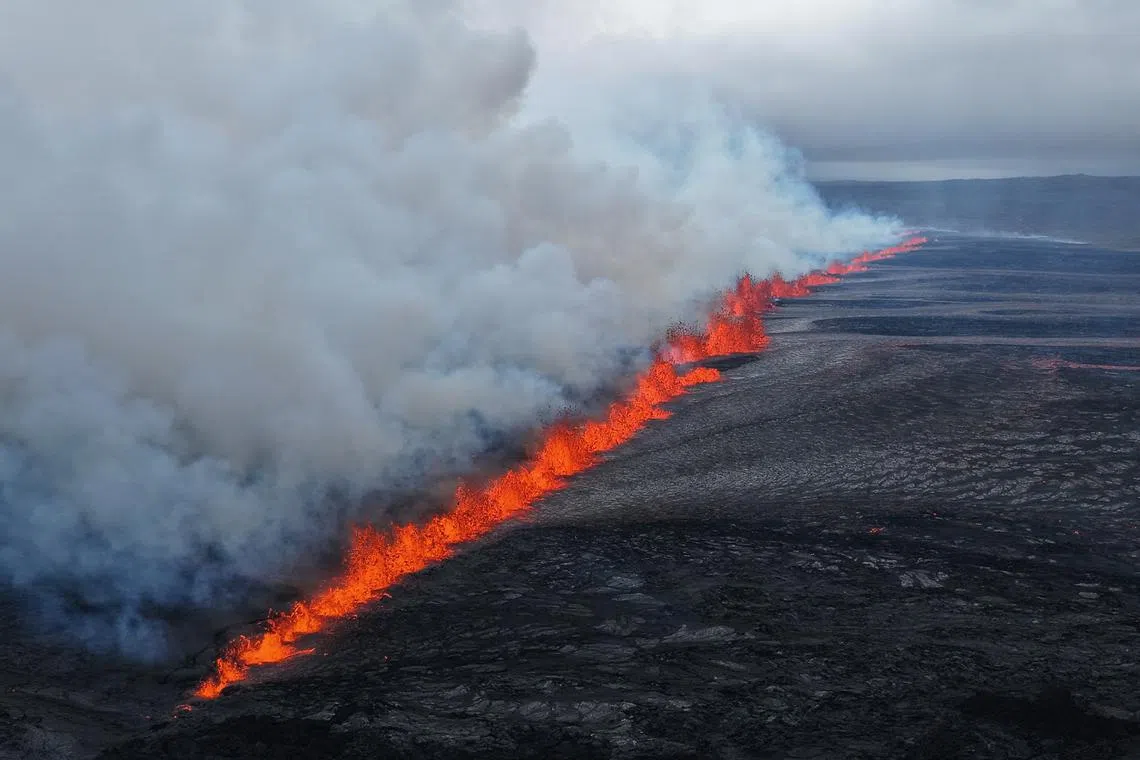Why do Iceland’s volcanoes keep erupting, and how dangerous are they?
Sign up now: Get ST's newsletters delivered to your inbox

Lava and smoke erupting from a volcano near Grindavik on the Icelandic peninsula of Reykjanes on July 16.
PHOTO: AFP
Follow topic:
Repeated volcanic eruptions have rocked south-western Iceland since December 2023, and the island’s inhabitants are getting used to the sight of lava spewing near populated areas.
For the wider world, the eruptions have rekindled memories of the Eyjafjallajokull explosion of 2010, when vast volcanic ash clouds grounded air traffic across Europe for weeks.
Scientists say the recent bout of heightened volcanic activity in the country known as “the land of fire and ice” may go on for centuries.
Is this normal for Iceland?
Yes and no. While the country experiences a volcanic eruption every five years on average – of varying nature, size and scope – the current series of eruptions is something even Icelanders are not used to.
The ground has ripped open 12 times since 2021
How did events unfold?
The Reykjanes region had seen little volcanic activity for about 800 years, until magma rose to the surface in 2021. It has emerged 12 times since then from relatively small fissures.
In a fissure eruption, liquid lava runs out and ash is not spewed into the atmosphere. While the first three eruptions happened in remote areas and posed little risk to people or infrastructure, some of the latter ones have resulted in the worst volcanic damage in the country in 50 years.
While deaths are uncommon, one person is presumed to have fallen into a crack in the ground near Grindavik and died.
In one of the eruptions, lava destroyed three homes on the northern edge of Grindavik. Earth barriers built to protect the houses have diverted most of the flow numerous times, but large and treacherous cracks have formed in the town, and most of its inhabitants have abandoned their homes.
Pipes that carry hot water from a power station to serve towns along the peninsula have been damaged repeatedly after lava flowed over them.
Could the latest eruption lead to wider disruption?
Probably not. A big ash cloud is very unlikely, as the magma keeps emerging on land rather than in water, where it can generate an explosive event and shoot ash up into the atmosphere.
That was what happened in the eruption of Eyjafjallajokull, when molten lava surged up and collided with melting glacier ice. None of the nine eruptions since 2023 have had an impact on air traffic.
Aviation regulations have also changed since 2010. Back then, the International Civil Aviation Organisation prohibited flying though airspace that contained, or was forecast to contain, ash particles. The concern was that abrasive, silica-based material from volcanoes could clog engines and scar windshields. Those rules were changed in 2014, leaving the decision on whether to fly down to the airlines themselves.
For Iceland, the need to rehouse 1 per cent of the population impacted by the eruptions has worsened an existing housing crisis, fuelling inflation and slowing the start of interest rate cuts by the central bank.
Is Iceland’s capital Reykjavik safe?
Reykjavik is located 40km north-east of the eruption site and is not considered to be in danger, although its inhabitants could experience reduced air quality.
Still, planners are reconsidering development patterns in the Reykjavik region, so the capital’s civic leaders could take new volcanic activity into account when they think about expanding the city.
Why are there so many volcanic eruptions in Iceland?
Iceland is one of the most geologically active places on Earth due to its position on the mid-Atlantic ridge between the North American and Eurasian tectonic plates. It has about 30 volcanic systems and more than 600 hot springs.
The ash plume from Eyjafjallajokull, situated under a glacier on the south coast of the island, was so vast that it led to the cancellation of 100,000 flights and affected more than 10 million people.
Other notable incidents include the Westman Islands eruption in 1973, which buried part of a fishing town home to 5,000 people under lava.
The biggest eruption in Iceland’s inhabited history happened in 1783 to 1784, when a row of craters in Laki, west of Europe’s biggest glacier, Vatnajokull, erupted and sparked the worst natural disaster since the country was settled.
In the aftermath, the poisonous fumes, which locals called “mist hardships”, disrupted the climate, crops and the livelihoods of people around the world. BLOOMBERG

